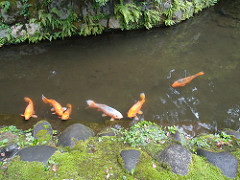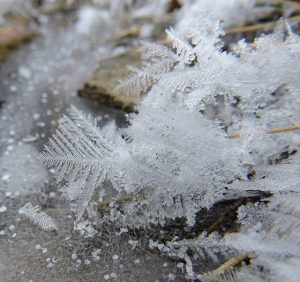Beauty Is Root Deep
 After having a conversation recently with another pond owner about plant issues, I was reminded of my painful experience with a particular species last year. I’m referring to the very popular, and very prolific, bamboo. I agree that it is an attractive plant and blends extremely well with a Koi water garden, but unfortunately it can be as destructive as it is beautiful. Several hundred species of bamboo have been imported into this country over the years by the horticultural industry for use as ornamental plants. And 24 of these are in the genus Phyllostachys, which is the most invasive and common of these plants. Although attractive from the ground up, from below they develop a dense, far-reaching and aggressive root system that is almost impossible to remove if you wish to get rid of it.
After having a conversation recently with another pond owner about plant issues, I was reminded of my painful experience with a particular species last year. I’m referring to the very popular, and very prolific, bamboo. I agree that it is an attractive plant and blends extremely well with a Koi water garden, but unfortunately it can be as destructive as it is beautiful. Several hundred species of bamboo have been imported into this country over the years by the horticultural industry for use as ornamental plants. And 24 of these are in the genus Phyllostachys, which is the most invasive and common of these plants. Although attractive from the ground up, from below they develop a dense, far-reaching and aggressive root system that is almost impossible to remove if you wish to get rid of it.
Two years ago we purchased dwarf bamboo thinking that dwarf meant small, manageable plants. Oh, were we wrong. By last year, the plants had begun to spread profusely despite our trimming. The worst part came when we realized that the reason our pond was continuously losing water was because the bamboo roots had spread under our entire stream leading to the pond. Its sharp root tips had poked hundreds of holes in the liner. Several days of removing the entire stream, rock liner, dirt and all, meant getting every possible root we could find. Any roots left, even the smallest, and you have bamboo back in no time. Again, I do like the look of bamboo, but if you decide you want to incorporate it into your water garden, I would strongly suggest keeping it confined to a container.
By Keith R. Heberling, Water Garden Expert

 For many of our pondkeepers, October means cooler temperatures and a change in landscape. The colors of fall bring beauty to your pond, but there is more to consider as you enjoy the crisp autumn air. Last month we talked about completing your “Big Fall Cleanup.” Once that is done, you should begin making plans to protect your pond and fish over the winter.
For many of our pondkeepers, October means cooler temperatures and a change in landscape. The colors of fall bring beauty to your pond, but there is more to consider as you enjoy the crisp autumn air. Last month we talked about completing your “Big Fall Cleanup.” Once that is done, you should begin making plans to protect your pond and fish over the winter. Yes, you read correctly. You can “tend” to your pond in the winter! When winter rolls around, many frustrated water gardeners can’t wait to begin working again on their water features, many of which have had little attention since November. Yet, instead of feeling restless, you can take advantage of winter to rest the pond, since aquatic (or even semi-aquatic) flora and fauna have expended much energy in the past year. During the cold weather, slowing biological processes provide protection against potential cold weather damage. Plus, the break from pond keeping will give you time to prepare for spring.
Yes, you read correctly. You can “tend” to your pond in the winter! When winter rolls around, many frustrated water gardeners can’t wait to begin working again on their water features, many of which have had little attention since November. Yet, instead of feeling restless, you can take advantage of winter to rest the pond, since aquatic (or even semi-aquatic) flora and fauna have expended much energy in the past year. During the cold weather, slowing biological processes provide protection against potential cold weather damage. Plus, the break from pond keeping will give you time to prepare for spring.